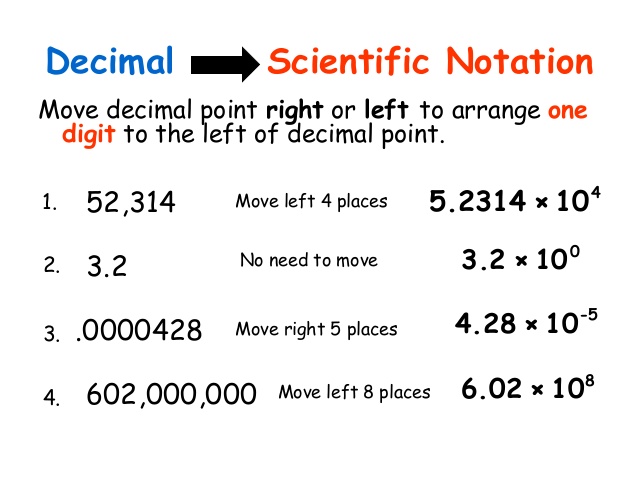Converting To and From Scientific Notation
Converting To Scientific Notation
To Change from Standard Form to Scientific Notation:
- Place the decimal point such that there is one non-zero digit to the left of the decimal point.
- Count the number of decimal places the decimal has “moved” from the original number. This will be the exponent of the 10.
- If the original number was less than 1, the exponent is negative; if the original number was greater than 1, the exponent is positive.

Examples:
- Given: 4,750,000
4.75 (moved decimal point 6 decimal places)
Answer: 4.75 × 106
The original number was greater than 1 so the exponent is positive. - Given: 0.000789
7.89 (moved decimal point 4 decimal places)
Answer: 7.89 × 10-4
The original number was less than 1 so the exponent is negative.
Converting From Scientific Notation
To Change from Scientific Notation to Standard Form:
- Move the decimal point to the right for positive exponents of 10. The exponent tells you how many places to move.
- Move the decimal point to the left for negative exponents of 10. Again, the exponent tells you how many places to move.

Examples:
- Given: 1.015 × 10-8
Answer: 0.00000001015 (moved decimal 8 places left)
Negative exponent moves decimal to the left. - Given: 5.024 × 103
Answer: 5,024 (move decimal 3 places right)
Positive exponent moves decimal to the right.
Read More About:
- What is the meaning of Place Value and Face Value in Maths?
- What is the Place Value Chart of an Indian and International System?
- What is a Decimal Value and Place Value of Decimals?
- How do you Round to the Nearest Ten Thousand
- What is the Definition of an Equivalent Decimal
- What is the Difference between Ascending and Descending Order
- Addition and Subtraction of Decimals
- How do you Multiply and Divide Decimals?
- How do you Convert Fractions into Decimals and Vice Versa
- How do you Convert Unlike Decimals into Like Decimals
